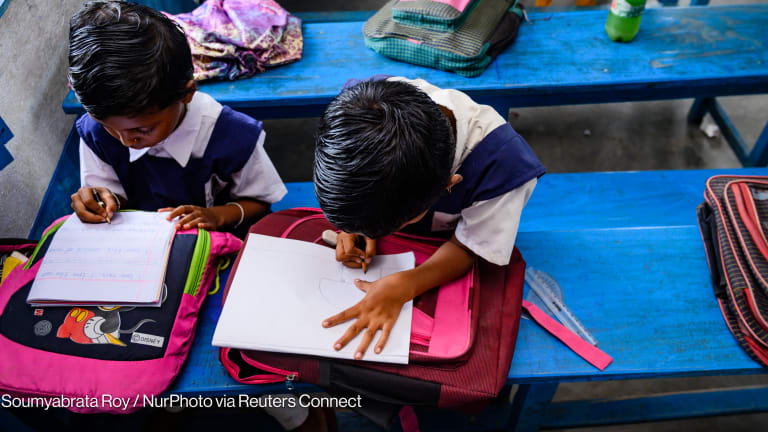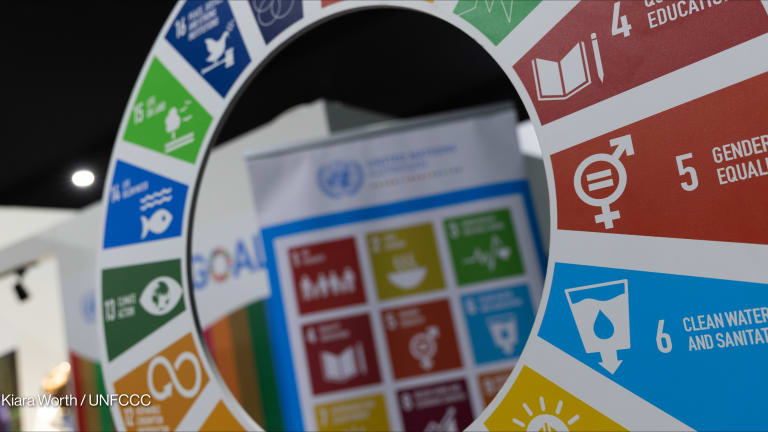Ed tech that's working in the poorest countries
Technology and education is a hot topic in the development sector. To find out what works and what doesn’t in the world's poorest communities, Devex spoke with World Bank's education and technology expert Michael Trucano.
Using technology to improve education has been the subject of great hype, controversy and disappointment in recent years. Sending laptops to the poor and tablets to developing countries’ schools has often been pitched as a quick fix solution to improving education standards. The evidence on outcomes is less convincing. For nongovernmental organizations in the field, technology can be a game changer — or a costly failure. To find out what works and what doesn’t, Devex spoke to Michael Trucano, senior education and technology policy specialist at the World Bank, for his perspective and tips to make best use of technology in the education of children in the world’s poorest communities. What are the development sector’s concerns with regards to using technologies such as tablets to deliver education in some of the world’s poorest communities? Evidence about the impact of the use of many educational technologies on things such as student learning outcomes is decidedly mixed around the world. Efforts like the high profile One Laptop Per Child initiative in Peru, which saw almost a million laptops purchased for students with little demonstrable impact on teaching and learning, represent cautionary tales for many international donors. That said, in many countries, “business as usual” when it comes to education is obviously not working very well either. The most recent Global Education Monitoring Report demonstrates that the gaps in educational attainment between rich and poor, within and between countries, are simply appalling. Where “business as usual” is not working, or not working quickly enough, many countries are considering “business unusual.” This involves a novel use of technology in some way, even where there is no rigorous evidence base which can inform the implementation of such technologies. Many international donors are rather wary about operating in such circumstances. Given these concerns, are there technologies you recommend avoiding entirely for education improvements in developing countries? With the best of intentions, and often “assisted” by commercial vendors, many groups have sought to simply transfer technology-based educational models and practices from classrooms in industrialized countries to less developed education systems in other parts of the world. Sometimes this works. But unfortunately many places roll out programs and products that have sets of assumptions at their core that do not correspond with local realities. These include reliable electricity and connectivity, well-trained teachers, sufficient available time-on-task, highly literate students, space to implement student-centric pedagogies, relevant content and a variety of cultural norms. The result is often not very good. Even where such assumptions hold, technology-based educational models that cannot be supported locally over time — such as models which are not locally sustainable — are usually best avoided. Today, this might include many of the most “cutting-edge” technologies being touted for use in education — things like virtual reality or augmented reality, for instance. Even if, as many of their most ardent proponents might argue, VR/AR may well represent “the future of educational technologies,” little of this stuff is ready for prime time in 2016. It is one thing for rich countries such as South Korea or the United States to explore the use of cutting-edge technologies to support learning in their schools tomorrow. However, given just how scarce resources are, and the size of the educational challenges they face, few low-income countries cannot afford to make speculative investments in cutting-edge research and development for educational technologies that aren't immediately practical today. The costs of failure are simply too high. We have discussed the negatives and what should be avoided, but what have you found are the best technologies that can be used to support education in the world's poorest communities? What can we expect to realistically support education in the future? Generally speaking, the best technology is the one you already have, know how to use and can afford. In many of the world's poorest communities, this technology is the mobile phone. Increasingly, and for better and for worse, most everyone has a mobile phone — and increasingly, these will be smartphones. Many low-income countries today are currently or are about to invest lots of money to help realize a traditional model of computer use in schools, such as purpose-built school computer labs, for the first time. At the same time, there is an installed infrastructure of mobile devices out there upon which they could alternatively build: the mobile phones in the hands of their teachers and learners. There are undeniable challenges to adopting a “mobile-first” approach to educational technology planning and use, related to technology, related to equity, related to imagination. There is no denying that. Many countries explicitly ban the use of phones in schools. I was once in a school in a low-income community in Brazil. Policymakers were considering purchasing lots of low-cost tablets for use in such places. In one classroom, I asked how many students had a personal mobile phone with them — all but one did. You are preparing to spend lots of money on handheld computing devices for use by students such as these in classrooms such as this one, I commented to the education officials who were with me. Has the fact that almost all of these same students already have a computing device with them factored into your decision-making in any way? For an NGO looking to incorporate technology into education programs, what suggestions and tips do you have? There are really two general types of innovations in education. The first type is the one most commonly considered: when something is done more efficiently, or cheaply, or faster, or at a wider scale than has happened before. Innovations in education of these sort are quite valuable and the most common. Improvement, iteration and expansion can drive progress in all sorts of useful ways, and doing what was done before, just better, is more likely to catch the attention of potential funders and partners than more radical or “out-of-the-box” approaches. That said, there is another type of innovation in education worth considering: where the use of new technologies can enable something that simply wasn't possible, or perhaps wasn't even conceivable, before. Such innovations are much more rare, of course, but it is precisely those sorts of innovations that can be truly transformational, possibly revolutionary for learners around the world. Which “innovation” you chose should depend on the particular context in which you are operating, and the particular needs, capacities and constraints found there. Whatever the challenge, if you have decided that technology is the answer, it might be worth taking a step back and asking: What is the question? Whatever the question, and the answer, NGOs would do well not to reproduce the same mistakes that have already been made, often many times, by other groups in other places. Given that many initiatives seem immune to learning from either “best” or even “good” practice in other places or contexts, it may be most practical to recommend lots of practice, as there appears to be a natural learning curve that accompanies large-scale adoption of ICTs in the education sector in many countries — even if this means “repeating the mistakes” of others. But do we really need to repeat the mistakes of others? If adopting “best practice” is fraught with difficulties, and “good practice” often noted but ignored, perhaps it is useful instead to look at worst practice. The good news is that, in the area of technology use in education, there appears to be a good deal of agreement about what this is. At a minimum, NGOs would do well to avoid already well-known worst practices of various sorts. If you are going to make a mistake, at least it should be a new one. Read more international development news online, and subscribe to The Development Newswire to receive the latest from the world’s leading donors and decision-makers — emailed to you FREE every business day.
Using technology to improve education has been the subject of great hype, controversy and disappointment in recent years. Sending laptops to the poor and tablets to developing countries’ schools has often been pitched as a quick fix solution to improving education standards. The evidence on outcomes is less convincing.
For nongovernmental organizations in the field, technology can be a game changer — or a costly failure. To find out what works and what doesn’t, Devex spoke to Michael Trucano, senior education and technology policy specialist at the World Bank, for his perspective and tips to make best use of technology in the education of children in the world’s poorest communities.
What are the development sector’s concerns with regards to using technologies such as tablets to deliver education in some of the world’s poorest communities?
This story is forDevex Promembers
Unlock this story now with a 15-day free trial of Devex Pro.
With a Devex Pro subscription you'll get access to deeper analysis and exclusive insights from our reporters and analysts.
Start my free trialRequest a group subscription Printing articles to share with others is a breach of our terms and conditions and copyright policy. Please use the sharing options on the left side of the article. Devex Pro members may share up to 10 articles per month using the Pro share tool ( ).
Lisa Cornish is a former Devex Senior Reporter based in Canberra, where she focuses on the Australian aid community. Lisa has worked with News Corp Australia as a data journalist and has been published throughout Australia in the Daily Telegraph in Melbourne, Herald Sun in Melbourne, Courier-Mail in Brisbane, and online through news.com.au. Lisa additionally consults with Australian government providing data analytics, reporting and visualization services.








